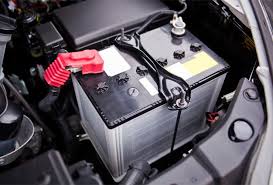WirralCar Repairs
Battery
- Lead Acid
- AGM

Common Issues
- SLOW ENGINE TURNOVER OR CLICKING
- DIM HEADLIGHTS AND ELECTRONIC ISSUES
- CHECK ENGINE AND OTHER INDICATOR LIGHTS
- BLOATED BATTERY CASE
- SULFUROUS SMELL (ROTTEN EGG)

WHAT IS A CAR BATTERY?
The battery is the foundation of your ride — it helps provide the jolt of electricity needed to power all of the electrical components of your vehicle. Understanding your car’s battery isn’t just a matter of automotive curiosity; it’s a necessity to help prevent getting stranded on the side of the road.
We’ll teach you how to spot the symptoms of a bad car battery and answer important questions like, “How does a car battery work?” and “How long do car batteries last?” Read on to learn everything you need to know about car batteries.
HOW DO CAR BATTERIES WORK?
Let’s take a look at how the most common type of car battery, lead acid; The car battery helps provide the jolt of electricity necessary to power all the electrical components in your vehicle. Talk about a pretty huge responsibility. Without battery power, your car, as you’ve probably noticed, won’t start.
Inside car batteries, there are cells comprised of a lead dioxide (PbO2) plate and a lead (Pb) plate. These cells are submerged in sulfuric acid, which creates a chemical reaction between the PbO2 plates and Pb plates. We won’t get too technical here, but through a series of chemical conversions, ions are produced. As these ions move back and forth between the plates, electricity is generated and sent to the terminals on your battery. From there, it can be distributed to the electric system of your vehicle.
One of the disadvantages of this system is that the batteries are filled with a caustic liquid that can leak if the battery is tipped over or cracked. Some standard lead acid batteries may also have to be topped off with deionized or distilled water occasionally.
Absorbent glass mat (AGM) batteries solve these problems by putting glass mat separators within the cells. These separators absorb the sulfuric acid and prevent it from sloshing around. AGM batteries are also typically sealed, which means that you don’t have to worry about topping off your battery’s fluid.
HOW LONG DO CAR BATTERIES LAST?
On average, car batteries last about three to five years, but external factors can drastically alter their longevity. Harsh climates, frequent short trips, and parasitic draws may accelerate wear and tear.
You can generally find the manufacturing date of your battery on a sticker on the side or top of your battery. Most date stickers are straightforward, but some use an alphanumeric code. In that case, the first part of the code is key: look for a letter and a digit. Letters are sequentially assigned to each month — A for January, B for February, and so on. The number that follows represents the last number of the year, as in 9 for 2019 and 3 for 2023.
Once your battery turns three years old, it’s a good idea to have it inspected yearly. Fortunately, peace of mind doesn’t have to be expensive. At Wirral Car Repair, we offer a free battery test any time you visit our locations.
SYMPTOMS OF A BAD CAR BATTERY
Without a working alternator, your car won't start in the near future or stay on for more than a few minutes. Yet the typical signs of a bad alternator are often mistaken for problems with the battery or other car parts that display similar symptoms. In other words, if you're experiencing only one of the issues below, it may be a sign of a bad alternator:
- SLOW ENGINE TURNOVER OR CLICKING
- DIM HEADLIGHTS AND ELECTRONIC ISSUES
- CHECK ENGINE AND OTHER INDICATOR LIGHTS
- BLOATED BATTERY CASE
- SULFUROUS SMELL (ROTTEN EGG)